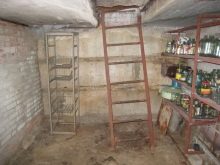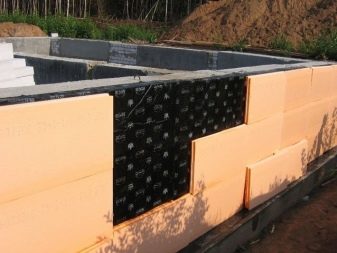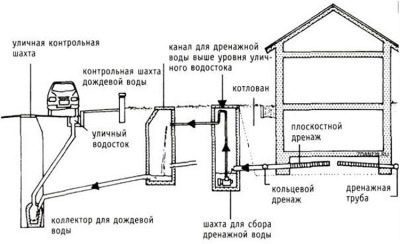How to get rid of the water in the cellar?

Residents of private houses sometimes ask themselves a question related to moisture in the basement. Such appeals to builders are especially frequent in the spring - with the onset of floods due to river floods. Some owners simply stop exploiting this part of the house, blaming nature for everything and thinking that waterproofing a basement is a difficult and expensive business. However, with the development of technology, it will not be difficult to make a basement waterproofing with your own hands.
How to avoid?
It is by no means worth cursing - it is easier (and often much more economical) to build a good cellar on the first try, rather than then endlessly modify, remodel. For this reason, at the same time, it is necessary to thoroughly seal the walls of the base of the house and remove water from it in a timely manner. If the water nevertheless made its way into the cellar, try to get rid of it as soon as possible in order to save the basement from excess moisture.



The far-sighted owner, already during the construction of the building, will definitely take care of the expedient organization of the drainage structure and the impeccable waterproofing of the basement rooms. The drainage system will undoubtedly help unnecessary moisture to go deep into the soil and not have any contact with the cellar, and moisture in the basement will not be a significant problem at all.
According to the perimeter of the basement of a previously built building, it is allowed to make drainage channels. And, if possible, fix them from inside the basement. In order to do this, as a rule, false parquet is used.
If the cellar is flooded or only floods, it is urgent to deal with the problem. If it floods from groundwater, then they need to be diverted and the structure drained, and in this way you can protect the cellar.

Zero-level foundation wall sealing
By saturating the soil near the base of the house, the water forms a hydrostatic effect that propels it through all damages and joints in the base of the house. Wet insulation will be the first safety feature.
Among the compositions specialized for this action, the most popular are materials containing bitumen, applied to the base of the house externally. Bitumen reduces the porosity of concrete, but later loses its flexibility and becomes more fragile, which leads to cracks. A variety of plasticizers improve the situation, but their protection will be short-lived.
Numerous developers prefer these coatings because of the low price, but buyers must be careful: the period of validity of such compounds is approximately 5-6 years.


Expanded polystyrene is effective in preserving the integrity of the coating when backfilling the base of the house. This material is stable, highly durable and resistant to bacteria living in the soil. Expanded polystyrene tiles promote thermal break between the base of the house (foundation) and the backfilled soil. Despite this, manufacturers claim that current highly flexible coatings do not require any protection, but there is no need to reject yet another insulation for the foundation walls in a residential building.
The surface must be cleaned before coating the concrete. In addition, the correct setting of the ground level is necessary at the end of the excavation work, and this factor should be taken into account when applying the coating.An incorrectly determined level will lead to the fact that under the backfill there will be a part of the wall without proper (or without any) waterproofing. Inevitable cracks from shrinkage in the foundation will eventually lead to leaks and shrinkage, therefore, the entire foundation must be processed with a margin.


Geocompositional drainage mats (consisting of a drainage base, a special filter and diaphragms) will replace the moisture-proof coatingattached to the walls of the base of the house.
The problem of using similar polymeric materials is corresponding: in the absence of effective drainage of the soil at the base of the house, water hydrostatic pressure will push water upward between the walls and mats. With this option, water will penetrate through various cracks in the foundation wall.


Sand and gravel - cleanliness in drainage pipes
In order to keep the basement dry, drainage from the building is important. The main component of the drainage structure can be an ordinary 100 mm PVC tube. This is because, in fact, it is difficult to put a special pipe with perforated slots directly, and every mistake in the gasket initiates clogging of the structures and a weak drain. In addition, the slots are rapidly clogged. In an ordinary pipe, it will not be difficult to drill a couple of rows of 12 mm holes. A series of layers of filter cloth wrapped around the pipe will prevent the pipe from collapsing.
Work on the part of water drainage begins with digging a trench right down to the bottom of the base of the house. Next, the filter material is unwound and placed with its edges in the ground according to the side trench walls.


Gravelite is poured on top of the matter, it is leveled, and then, with a slight orientation, a polyvinyl chloride tube is placed at the edge of the outlet pipe. In this step, it is necessary to combine with vertical risers the inlets located in the plane with the drainage pipes of the foundation sole. In the future, the water intake grids are filled with gravel so that they do not get clogged with debris.
Gravel is poured over the pipe. Its level should not reach the upper edge of the sole about 20 cm. From above it is covered with a filter cloth. In order to contain it, another row of gravel or several shovels of sand are laid on top.
For the purpose of more unhurried clogging of the filter material, about 15 cm of sand is thrown from above it. As a result, there is a stable and efficient operation of the drainage structure (the sand protects the material, and the material protects the pebble).


With this arrangement, moisture in the basement is unlikely to be a problem. External drainage of the foundation base must be carried out with a direction of 2-3 cm per 1 m of the pipe length (or more). If the total length of drainage structures exceeds 60 m, then it is necessary to think about additional criteria, for example, about increasing the diameter of the outlet pipe.
If there is no significant tilt in place or there is no storm sewer channel nearby, then it will be necessary to bring the drainages of the base of the house to the pump. In this case, the tube connecting the external contour of the drainage structure with the pump is led to the header according to the shortest route.


It is worth highlighting that the inner contour of the drainage structure should not be combined with its outer sector in any way.
This is due to the fact that the threat of problems in the external component is significantly greater than in the internal one: a violation in the external contour of the connected structures will lead to flooding of the basement, as water will begin to follow under the mansion.
Overwetting of the backfill is considered to be the cause of a huge share of problems with water under the dwelling. The coating spray applied to the concrete blocks the water admission due to various disadvantages of the base of the house. A perforated PVC tube filled along the sole of the base of the house drains excess water away from the building.A special filter made of gravel, sand and a special canvas protects the drainage structure from flooding.
If you do not worry about the drainage of rainwater flowing from the roof, it will end up in the cellar.



Organization of drainage
In addition, a competent drainage system will help solve the problem of water in the basement. Taking water from the gutters away from the building - this solution may seem at first glance to be true. However, not all buildings have effective rainwater drainage. Another method to divert rainwater is to combine drainpipes with a multi-outlet, which has a strong slope from the building.
Due to the accumulation of debris in the gutters, the diameter of the drain pipes should contribute to a reliable drainage of moisture, including during a rainstorm - no less than 100 mm. In this case, the best branch pipe for the structure is 150 mm.


In the drainage channel, all kinds of twists and turns are not welcome, since they will certainly become clogged with a variety of debris and other elements of life. If the length of the gutter is more than 5 m, then several outlet channels should be considered.
And one more thing: the drainage pipe of rain gutters should not be connected to the drainage system of the sole of the base of the house. The most likely clogging of the drainage structure can develop into a blockage of the entire drainage structure.
What to do and how to uninstall?
The internal drainage circuit (concentrates water from the walls of the basement of the house), insulation near the concrete slab (does not allow steam and water to rise up in any way), a durable pumping out electric water pump - these are the three elements of an effective basement drainage structure.

A 20–25 cm wide gravel layer is placed under the concrete slab. This fill is a strong cushion for the concrete, allowing drainage under the slab. After the gravel has been laid, a vapor barrier made of high-density cellophane is installed. The canvases overlap, the smallest one is 40-50 cm, and the joints are sealed with the support of adhesive tape.
This isolation is not supported by concrete specialists, since it cannot allow moisture from the solution to go into the ground, and this lengthens the technological cycle. However, this task is solved by a sand layer filled over the insulation with a width of 70–80 mm.
The second option is isolation under gravel. In each case, the short-lived benefits of intact insulation underneath the structure are worth the short-term installation inconvenience.


The joint between the basement floor and the wall of the basement of the house is the best space for picking up and draining water that enters the basement. A rather effective method of capturing water is considered to be a plastic profile located under a concrete slab. This kind of apron traps water seeping through the walls. Holes in the profile allow moisture to penetrate into the gravel near the slab, from where the water is pumped out.
How to choose?
A well-functioning electric water pump is the basis of drainage structures. The quality of removing excess moisture depends on how correctly and correctly it works. There are a number of criteria that you need to pay attention to when choosing this device.
- First of all, the structure should have a metal (cast iron) block-body.
- It is also necessary to be able to pump out dirty water with rigid connections 10–12 mm in size.
- And it is also important that the pump has an automatic float switch, which is very unpretentious and simple from a technical point of view.


The pump is located in the middle of a plastic water trap that filters and collects water. Such a perforated container is installed in the filler layer. Water enters the collector from the internal circuit of the drainage structures through its side wall.The tank must have an airtight cover: it will prevent the evaporation of moisture that can get into the basement, and also protect the water collector from various objects that can upset the operation of the switch.
But it is very dangerous to trust the dryness of the basement only to the pump. When the building is de-energized due to a storm, the cellar will quickly fill up with water. In order to be on the safe side, the structure is equipped with a spare battery-powered pump, mounted in the water collector where the main pump is located. The discharge air line can be used for it the same.


Very efficient systems use pumps that are equipped with accumulators and filling devices for long-term additional use. The charger is extremely important, as untimely recharging can lead to flooding of the basement.
The pumped-out water, as a rule, is fed through a pipeline into the drain, if any, or taken out as far as possible from the building. It is necessary to install the discharge air duct in such a way that in winter it does not freeze in any way.
Trust the installation of such systems only to specialists. If you do the work yourself, there are huge risks of harming both the foundation and the building as a whole.


Our recommendations will help you fix leaks and remove residual water.
For information on how to make a dry cellar, see the next video.










The comment was sent successfully.